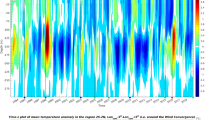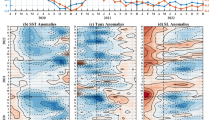Abstract
Compared to the La Niña event in the first-year, the air-sea system is not well coupled during the second-year. This is evidenced by the generally weaker anomalous sea surface temperature (SST) and the significantly stronger easterly wind anomalies. According to the Bjerknes positive feedback, the strong easterly wind anomalies are challenging to explain using only the zonal gradient of the sea level pressure (SLP) anomaly. This is due to the incursion of the off-equatorial southeasterly wind originating from the southeast Pacific before the onset of the second-year event. It results in a distinctive development feature in the event, distinguishing it from the first-year event, which is a typical result of equatorial ocean–atmosphere interaction. The different roles of the off-equatorial signal and equatorial easterly wind indicate a relay process in which the former mainly plays a triggering role, while the latter primarily acts as a reinforcing role in the second-year event. Furthermore, the zonal advective feedback plays a crucial role in determining the amplitude of the second-year cold event, which is a main difference from the first-year event. The reduced intensity produces a relatively weaker SST amplitude during the second-year La Niña event due to the thicker mixed layer depth.








Similar content being viewed by others
Data availability
The monthly wind stress, current field, and subsurface temperature data from NCEP Global Ocean Data Assimilation System (GODAS) can be obtained at https://psl.noaa.gov/data/gridded/data.godas.html. The monthly precipitation data from Climate Prediction Center (NOAA) Merged Analysis of Precipitation data was obtained https://psl.noaa.gov/data/gridded/data.cmap.html. The monthly sea surface temperature data can be derived from extended reconstructed SST (NOAA), v5 (https://psl.noaa.gov/data/gridded/data.noaa.ersst.v5.html), and the monthly sea level pressure and associated radiation flux data from the NCEP Reanalysis II (R2) can be obtained from https://psl.noaa.gov/data/gridded/data.ncep.reanalysis2.html.
References
Alexander MA et al (2010) The impact of extratropical atmospheric variability on ENSO: Testing the seasonal footprinting mechanism using coupled model experiments. J Clim 23(11):2885–2901. https://doi.org/10.1175/2010jcli3205.1
Barnston AG et al (2012) The skill of real-time seasonal ENSO model predictions during 2002–11: Is our capability increasing? Bull Amer Meteorol Soc 93(5):631–651. https://doi.org/10.1175/BAMS-D-11-00111.1
Bjerknes J (1969) Atmospheric teleconnections from the equatorial Pacific. Mon Weather Rev 97(3):163–172. https://doi.org/10.1175/1520-0493(1969)097%3c0163:atftep%3e2.3.co;2
Cao T, Zheng F, Fang X (2022) Key processes on triggering the moderate 2020/21 La Niña event as depicted by the clustering approach. Front Earth Sci 10:822854. https://doi.org/10.3389/feart.2022.822854
Chen N, Fang X (2023) A simple multiscale intermediate coupled stochastic model for El Niño diversity and complexity. J Adv Model Earth Sy 15(4):e2022MS003469. https://doi.org/10.1029/2022MS003469
Chen SF, Yu B, Chen W (2014) An analysis on the physical process of the influence of AO and ENSO. Clim Dyn 42:973–989. https://doi.org/10.1007/s00382-012-1654-z
Chen H-C et al (2020) Enhancing the ENSO predictability beyond the spring barrier. Sci Rep 10(1):984. https://doi.org/10.1038/s41598-020-57853-7
Chen N, Fang X, Yu JY (2022) A multiscale model for El Niño complexity. NPJ Clim Atmos Sci 5(1):16. https://doi.org/10.1038/s41612-022-00241-x
DiNezio PN et al (2017) Predictability of 2-year La Niña events in a coupled general circulation model. Clim Dyn 49(11–12):4237–4261. https://doi.org/10.1007/s00382-017-3575-3
Durack PJ, Wijffels SE (2010) Fifty-year trends in global ocean salinities and their relationship to broad-scale warming. J Clim 23(16):4342–4362. https://doi.org/10.1175/2010JCLI3377.1
Fang SW, Yu JY (2020) A control of ENSO transition complexity by tropical Pacific mean SSTs through tropical‐subtropical interaction. Geophys Res Lett 47(12):e2020GL087933. https://doi.org/10.1029/2020GL087933
Fang X, Chen N (2023) Quantifying the predictability of ENSO complexity using a statistically accurate multiscale stochastic model and information theory. J Clim 36(8):2681–2702. https://doi.org/10.1175/JCLI-D-22-0151.1
Fang X-H, Zheng F (2021) Effect of the air–sea coupled system change on the ENSO evolution from boreal spring. Clim Dyn 57(1–2):109–120. https://doi.org/10.1007/s00382-021-05697-w
Fang X-H, Zheng F, Zhu J (2015) The cloud-radiative effect when simulating strength asymmetry in two types of El Niño events using CMIP5 models. J Geophys Res Oceans 120:4357–4369. https://doi.org/10.1002/2014JC010683
Fang XH et al (2023) Will the historic southeasterly wind over the equatorial Pacific in March 2022 trigger a third-year La Niña event? Adv Atmos Sci 40:6–13. https://doi.org/10.1007/s00376-022-2147-6
Feng L et al (2015) The role of stochastic model error perturbations in predicting the 2011/12 double-dip La Niña. SOLA 11:65–69. https://doi.org/10.2151/sola.2015-014
Feng L et al (2020) Roles of wind stress and subsurface cold water in the second-year cooling of the 2017/18 La Niña event. Adv Atmos Sci 37:847–860. https://doi.org/10.1007/s00376-020-0028-4
Gao C, Zhang RH (2017) The roles of atmospheric wind and entrained water temperature (Te) in the second-year cooling of the 2010–12 La Niña event. Clim Dyn 48:597–617. https://doi.org/10.1007/s00382-016-3097-4
Geng T et al (2023) Increased occurrences of consecutive La Niña events under global warming. Nature 619(7971):774–781. https://doi.org/10.1038/s41586-023-06236-9
Hasan NA, Chikamoto Y, McPhaden MJ (2022) The influence of tropical basin interactions on the 2020–2022 double-dip La Niña. Front Clim 4:1001174. https://doi.org/10.3389/fclim.2022.1001174
Holland PW, Welsch RE (1977) Robust regression using iteratively reweighted least-squares. Commun Stat Theor Methods 6(9):813–827. https://doi.org/10.1080/03610927708827533
Hu S, Fedorov AV (2018) Cross-equatorial winds control El Niño diversity and change. Nat Clim Change 8(9):798–802. https://doi.org/10.1038/s41558-018-0248-0
Hu Z-Z et al (2014) Why were some La Niñas followed by another La Niña? Clim Dyn 42:1029–1042. https://doi.org/10.1007/s00382-013-1917-3
Hu Z-Z et al (2020) The interdecadal shift of ENSO properties in 1999/2000: A review. J Clim 33(11):4441–4462. https://doi.org/10.1175/JCLI-D-19-0316.1
Huang B et al (2017) Extended reconstructed sea surface temperature version 5 (ERSSTv5), upgrades, validations, and intercomparisons. J Clim 30(20):8179–8205. https://doi.org/10.1175/JCLI-D-16-0836.1
Jin F-F (1997) An equatorial ocean recharge paradigm for ENSO. Part I: Conceptual model. J Atmos Sci 54(7):811–829. https://doi.org/10.1175/1520-0469(1997)054%3c0811:aeorpf%3e2.0.co;2
Jin F-F, Kim ST, Bejarano L (2006) A coupled-stability index for ENSO. Geophys Res Lett 33:L23708. https://doi.org/10.1029/2006GL027221
Jin EK et al (2008) Current status of ENSO prediction skill in coupled ocean-atmosphere models. Clim Dyn 31(6):647–664. https://doi.org/10.1007/s00382-008-0397-3
Kanamitsu M et al (2002) NCEP–DOE AMIP-II reanalysis (R-2). Bull Amer Meteor Soc 83(11):1631–1644. https://doi.org/10.1175/bams-83-11-1631
Kim ST, Jin F-F (2011) An ENSO stability analysis. Part I: Results from a hybrid coupled model. Clim Dyn 36(7–8):1593–1607. https://doi.org/10.1007/s00382-010-0796-0
Li X et al (2022) A historical perspective of the La Niña event in 2020/21. J Geophys Res Atmos 127:e2021JD035546. https://doi.org/10.1029/2021JD035546
Lin J-L (2007) The double-ITCZ Problem in IPCC AR4 coupled GCMs: Ocean-atmosphere feedback analysis. J Clim 20:4497–4525. https://doi.org/10.1175/jcli4272.1
Lübbecke JF, McPhaden MJ (2013) A comparative stability analysis of Atlantic and Pacific Niño modes. J Clim 26:5965–5980. https://doi.org/10.1175/jcli-d-12-00758.1
Lübbecke JF, McPhaden MJ (2014) Assessing the Twenty-First-Century Shift in ENSO Variability in Terms of the Bjerknes Stability Index. J Clim 27(7):2577–2587. https://doi.org/10.1175/jcli-d-13-00438.1
Luo J-J et al (2017) Inter-basin sources for two-year predictability of the multi-year La Niña event in 2010–2012. Sci Rep 7(1):2276. https://doi.org/10.1038/s41598-017-01479-9
McPhaden MJ, Zhang X (2009) Asymmetry in zonal phase propagation of ENSO sea surface temperature anomalies. Geophys Res Lett 36(13):L13703. https://doi.org/10.1029/2009GL038774
Park J et al (2020) Mid-latitude leading double-dip La Niña. Int J Climatol 41:E1353–E1370. https://doi.org/10.1002/joc.6772
Ren H-L et al (2017) Prediction of primary climate variability modes at the Beijing Climate Center. J Meteor Res 31(1):204–223. https://doi.org/10.1007/s13351-017-6097-3
Ren H-L et al (2020) A review of research on tropical air-sea interaction, ENSO dynamics, and ENSO prediction in China. J Meteor Res 34(1):43–62. https://doi.org/10.1007/s13351-020-9155-1
Rousseeuw RJ, Leroy AM (1987) Robust Regression and Outlier Detection. John Wiley, New York
Saha S et al (2006) The NCEP Climate Forecast System. J Clim 19(15):3483–3517. https://doi.org/10.1175/jcli3812.1
Song C et al (2022) The roles of off-equatorial subsurface cold-water incursions in triggering the second-year cooling of the La Niña event in 2021. J Mar Sci Eng 10:1667. https://doi.org/10.3390/jmse10111667
Timmermann A et al (2018) El Niño–southern oscillation complexity. Nature 559(7715):535–545. https://doi.org/10.1038/s41586-018-0252-6
Wang B et al (2023) Understanding the recent increase in multiyear La Niñas. Nat Clim Change 13(10):1075–1081. https://doi.org/10.1038/s41558-023-01801-6
Wang C et al (2017) El Niño and Southern Oscillation (ENSO): a review. Coral reefs of the Eastern Tropical Pacific: persistence and loss in a dynamic. In: Environment PW, Glynn DP, Mazello, Enoch IC (eds) Coral reefs of the world, vol 8. Springer, Dordrecht, pp 85–106. https://doi.org/10.1007/978-94091707499-4_4
Wu X et al (2019) What controls the duration of El Niño and La Niña events? J Clim 32:5941–5965. https://doi.org/10.1175/JCLI-D-18-0681.1
Xie P, Arkin PA (1997) Global precipitation: a 17-year monthly analysis based on gauge observations, satellite estimates, and numerical model outputs. Bull Amer Meteor Soc 78:2539–2558. https://doi.org/10.1175/1520-0477(1997)078%3c2539:GPAYMA%3e2.0.CO;2
Xue Y et al (2013) Prediction skill and bias of tropical pacific sea surface temperatures in the NCEP climate forecast system version 2. J Clim 26:5358–5378. https://doi.org/10.1175/JCLI-D-12-00600.1
Yeh SW et al (2009) El Niño in a changing climate. Nature 461(7263):511–514. https://doi.org/10.1038/nature08316
Yu J-Y, Fang S-W (2018) The distinct contributions of the seasonal footprinting and charged-discharged mechanisms to ENSO complexity. Geophys Res Lett 45(13):6611–6618. https://doi.org/10.1029/2018GL007664
Zhang R-H et al (2013) A successful real-time forecast of the 2010–11 La Niña event. Sci Rep 3:1108. https://doi.org/10.1038/srep01108
Zhang H, Clement A, Di Nezio P (2014) The South Pacific Meridional Mode: A Mechanism for ENSO-like Variability. J Clim 27(2):769–783. https://doi.org/10.1175/jcli-d-13-00082.1
Zhang R-H et al (2020) A review of progress in coupled ocean-atmosphere model developments for ENSO studies in China. J Ocean Limnol 38(4):930–961. https://doi.org/10.1007/s00343-020-0157-8
Zhang R-H, Gao C, Feng L (2022) Recent ENSO evolution and its real-time prediction challenges. Natl Sci Rev 9(4):nwac052. https://doi.org/10.1093/nsr/nwac052
Zheng F, Zhu J (2016) Improved Ensemble-Mean Forecasting of ENSO Events by a Zero-Mean Stochastic Error Model of an Intermediate Coupled Model. Clim Dyn 47(12):3901–3915. https://doi.org/10.1007/s00382-016-3048-0
Zheng F, Feng L, Zhu J (2015) An incursion of off-equatorial subsurface cold water and its role in triggering the “double dip” La Niña event of 2011. Adv Atmos Sci 32(6):731–742. https://doi.org/10.1007/s00376-014-4080-9
Zheng F et al (2016) Modulation of Bjerknes feedback on the decadal variations in ENSO predictability. Geophys Res Lett 43(24):12560–12568. https://doi.org/10.1002/2016GL071636
Zheng F et al (2014) Asymmetry of the Bjerknes positive feedback between the two types of El Niño. Geophys Res Lett 41(21):7651–7657. https://doi.org/10.1002/2014GL062125
Zhou T, Wu B, Dong L (2014) Advances in research of ENSO changes and the associated impacts on Asian-Pacific climate. Asia-Pac J Atmos Sci 50(4):405–422. https://doi.org/10.1007/s13143-014-0043-4
Acknowledgements
This work was supported by the National Natural Science Foundation of China (Grant No. 42175045), the Key Research Program of Frontier Sciences, CAS (Grant No. ZDBS-LY-DQC010), and the Strategic Priority Research Program of the Chinese Academy of Sciences (Grant No. XDB42000000).
Funding
The authors have not disclosed any funding.
Author information
Authors and Affiliations
Corresponding author
Ethics declarations
Ethical statements
This study strictly adheres to ethical standards, and we affirm that we have no conflicts of interest with any individual, institution, or organization involved in this study, and we have not received any form of external funding. We are dedicated to upholding the authenticity and integrity of the study's results, and the data has been processed and analyzed in compliance with ethical standards, ensuring there has been no manipulation or fabrication of data. Throughout the study, we have upheld the principle of non-discrimination and have not exhibited bias against study participants based on their race, gender, age, or religious beliefs.
Competing interests
The authors declare no competing interests.
Additional information
Publisher's Note
Springer Nature remains neutral with regard to jurisdictional claims in published maps and institutional affiliations.
Rights and permissions
Springer Nature or its licensor (e.g. a society or other partner) holds exclusive rights to this article under a publishing agreement with the author(s) or other rightsholder(s); author self-archiving of the accepted manuscript version of this article is solely governed by the terms of such publishing agreement and applicable law.
About this article
Cite this article
Cao, TW., Zheng, F. & Fang, XH. The asymmetry of air-sea coupled strength between the first-year and second-year La Niña events. Clim Dyn (2024). https://doi.org/10.1007/s00382-024-07259-2
Received:
Accepted:
Published:
DOI: https://doi.org/10.1007/s00382-024-07259-2




